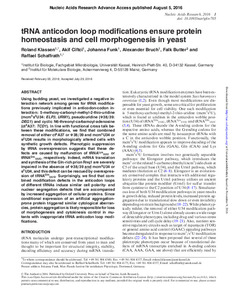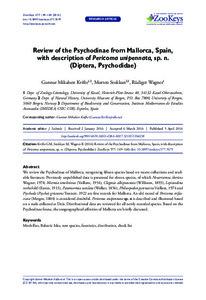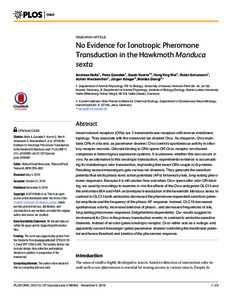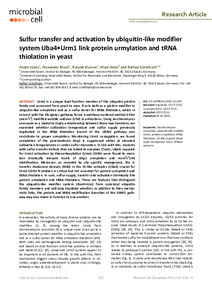Suche
Anzeige der Dokumente 1-5 von 5
Aufsatz
 Immunolocalization of Arthropsin in the Onychophoran Euperipatoides rowelli (Peripatopsidae)
Immunolocalization of Arthropsin in the Onychophoran Euperipatoides rowelli (Peripatopsidae)
(2016-08-04)
Opsins are light-sensitive proteins that play a key role in animal vision and are related to the ancient photoreceptive molecule rhodopsin found in unicellular organisms. In general, opsins involved in vision comprise two major groups: the rhabdomeric (r-opsins) and the ciliary opsins (c-opsins). The functionality of opsins, which is dependent on their protein structure, may have changed during evolution. In arthropods, typically r-opsins are responsible for vision, whereas in vertebrates c-opsins are components of ...
Aufsatz
 tRNA anticodon loop modifications ensure protein homeostasis and cell morphogenesis in yeast
tRNA anticodon loop modifications ensure protein homeostasis and cell morphogenesis in yeast
(2016-08-05)
Using budding yeast, we investigated a negative interaction network among genes for tRNA modifications previously implicated in anticodon-codon interaction: 5-methoxy-carbonyl-methyl-2-thio-uridine (mcm5s2U34: ELP3, URM1), pseudouridine (Ψ38/39: DEG1) and cyclic N6-threonyl-carbamoyl-adenosine (ct6A37: TCD1). In line with functional cross talk between these modifications, we find that combined removal of either ct6A37 or Ψ38/39 and mcm5U34 or s2U34 results in morphologically altered cells with synthetic growth defects. ...
Aufsatz
 Review of the Psychodinae from Mallorca, Spain, with description of Pericoma unipennata, sp. n. (Diptera, Psychodidae)
Review of the Psychodinae from Mallorca, Spain, with description of Pericoma unipennata, sp. n. (Diptera, Psychodidae)
(2016-04-05)
We review the Psychodinae of Mallorca, recognising fifteen species based on recent collections and available literature. Previously unpublished data is presented for eleven species, of which Neoarisemus ibericus Wagner, 1978, Mormia tenebricosa (Vaillant, 1954), Clogmia albipunctata (Williston, 1893), Lepiseodina rothschildi (Eaton, 1913), Paramormia ustulata (Walker, 1856), Philosepedon pyrenaicus Vaillant, 1974 and Psychoda (Psycha) grisescens Tonnoir, 1922 are first records for Mallorca. An old record of Pericoma ...
Aufsatz
 No Evidence for Ionotropic Pheromone Transduction in the Hawkmoth Manduca sexta
No Evidence for Ionotropic Pheromone Transduction in the Hawkmoth Manduca sexta
(2016-11-09)
Insect odorant receptors (ORs) are 7-transmembrane receptors with inverse membrane topology. They associate with the conserved ion channel Orco. As chaperon, Orco maintains ORs in cilia and, as pacemaker channel, Orco controls spontaneous activity in olfactory receptor neurons. Odorant binding to ORs opens OR-Orco receptor ion channel complexes in heterologous expression systems. It is unknown, whether this also occurs in vivo. As an alternative to this ionotropic transduction, experimental evidence is accumulating ...
Aufsatz
 Sulfur transfer and activation by ubiquitin-like modifier system Uba4•Urm1 link protein urmylation and tRNA thiolation in yeast
Sulfur transfer and activation by ubiquitin-like modifier system Uba4•Urm1 link protein urmylation and tRNA thiolation in yeast
(2016-10-24)
Urm1 is a unique dual-function member of the ubiquitin protein family and conserved from yeast to man. It acts both as a protein modifier in ubiquitin-like urmylation and as a sulfur donor for tRNA thiolation, which in concert with the Elongator pathway forms 5-methoxy-carbonyl-methyl-2-thio (mcm5s2) modified wobble uridines (U34) in anticodons. Using Saccharomyces cerevisiae as a model to study a relationship between these two functions, we examined whether cultivation temperature and sulfur supply previously ...





